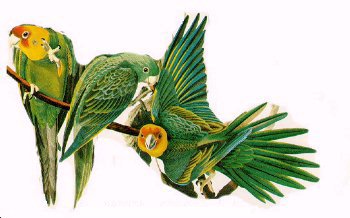Extinct Birds the Lenape Knew
The two birds shown below were well known to the Lenape people. Now they are both extinct. Only the Lenape name for the Passenger Pigeon is remembered. As we were forced westward we moved out of the area where the Carolina Parakeets were and their name became lost to us.
We are showing these two illustrations by the painter John James Audubon to remind those who view these pages how fragile the other inhabitants of our world can be, and how we all need to take care of our “Mother Earth.”
Click on the Lenape name to hear the bird’s name as pronounced by Lenape speaker Nora Thompson Dean.
 |
Amimi
Passenger Pigeon (Ectopistes migratorius) NOW EXTINCT !! |
 Carolina Parakeets |
The Passenger Pigeon was one of the most abundant bird species on earth not long ago. Lenape elder Ohëlëmitakwsi (James Thompson) told how, when he was a boy in Indian Territory (now Oklahoma) in the 1870s, he saw a flock fly over, and it took almost twenty minutes for them to pass.
They were driven to extinction by uncontrolled commercial hunting for the settlers. The pigeons’ migration and nesting made them easy to hunt in large numbers. By 1850, several thousand people were employed in the passenger pigeon industry. In New York, one operation alone processed 18,000 pigeons each day in 1855.
In 1914 the last Passenger Pigeon died at the Cincinnati Zoo. Before their extermination, a single flock of passenger pigeons could have two billion birds or more, and there were many flocks in the United States.
The Carolina Parakeet was America’s only native parrot. They lived over much of the United States east of the great plains. Their numbers began to decrease in the early 1800s. As the settlers began to farm more land, the Parakeets would flock to the fields and orchards, destroying the crops. The settlers could easily kill the birds as when one of their flock was shot, the others would fly around their fallen friend instead of flying away for safety. It was because of this behavior that the entire flock could easily be destroyed.
The birds were also shot for their colorful feathers which were sold to decorate women’s hats. It is also thought that the destruction of their habitat may have contributed to their decline. By the 1890s, Carolina Parakeets were very rare.
The last known pair of Carolina Parakeets had lived in the Cincinnati Zoo for thirty-five years, and they were named “Incas” and “Lady Jane.” In the summer of 1917, Lady Jane died, leaving Incas spiritless and mournful, and alone, the last of his kind, he “died of grief” on 21 February 1918.
 D5 Creation
D5 Creation